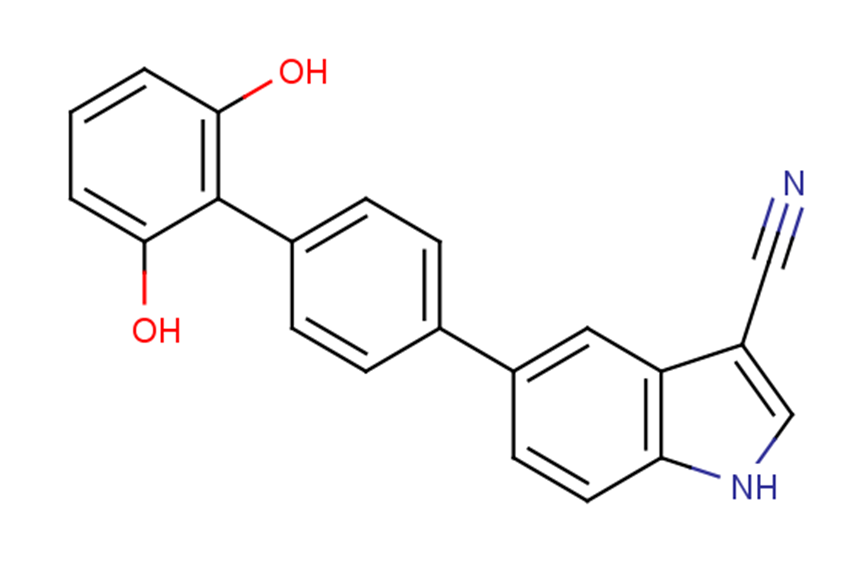
MT 63-78
CAS No. 1179347-65-9
MT 63-78( —— )
Catalog No. M22461 CAS No. 1179347-65-9
MT 63-78 is a specific and effective direct AMPK activator (EC50: 25 μM). MT 63-78 blocks prostate cancer growth by inhibiting the lipogenesis and mTORC1 pathways.
Purity : >98% (HPLC)
 COA
COA
 Datasheet
Datasheet
 HNMR
HNMR
 HPLC
HPLC
 MSDS
MSDS
 Handing Instructions
Handing Instructions
| Size | Price / USD | Stock | Quantity |
| 2MG | 101 | In Stock |


|
| 5MG | 155 | In Stock |


|
| 10MG | 260 | In Stock |


|
| 25MG | 440 | In Stock |


|
| 50MG | 617 | In Stock |


|
| 100MG | 872 | In Stock |


|
| 200MG | Get Quote | In Stock |


|
| 500MG | Get Quote | In Stock |


|
| 1G | Get Quote | In Stock |


|
Biological Information
-
Product NameMT 63-78
-
NoteResearch use only, not for human use.
-
Brief DescriptionMT 63-78 is a specific and effective direct AMPK activator (EC50: 25 μM). MT 63-78 blocks prostate cancer growth by inhibiting the lipogenesis and mTORC1 pathways.
-
DescriptionMT 63-78 is a specific and effective direct AMPK activator (EC50: 25 μM). MT 63-78 blocks prostate cancer growth by inhibiting the lipogenesis and mTORC1 pathways. MT 63-78 has antitumor effects. MT 63–78 also causes cell mitotic arrest and apoptosis.MT 63-78 (0-50 μM; 24 hours; LNCaP, PC3, C4-4, C4-2B, CL1and 22RV1cells) treatment induces reduction of anti-apoptotic Mcl-1 in concert with an accumulation of the pro-apoptotic BH3-only protein Puma. MT 63-78 (0-50 μM; 4 days; LNCaP and PC3 cells) treatment displays a dose-dependent decrease in cell number and concomitant to the activation of AMPK signaling. MT 63-78 (0-50 μM; 30 minutes; LNCaP and PC3 cells) treatment shows dose-dependent phosphorylation of the two major AMPK targets Acetyl-CoA Carboxylase (ACC) on Ser79 and of Raptor on Ser792. And also increases Thr172 phosphorylation on the AMPK α subunit. MT 63-78 (25 μM; 24 hours; LNCaP and CRPC cells) treatment causes a significant enrichment in the G2/M population .MT 63-78 (30 mg/kg; intraperitoneal injection; daily; for 14 days; C57 BL/6 male mice) treatment causes a 33% inhibition of tumor growth.
-
In VitroMT 63-78 (0-50 μM; 4 days; LNCaP and PC3 cells) treatment shows a dose-dependent decrease in cell number, and concomitant to the activation of AMPK signaling.MT 63-78 (25 μM; 24 hours; LNCaP and CRPC cells) treatment induces a significant enrichement in the G2/M population.MT 63-78 (0-50 μM; 24 hours; LNCaP, PC3, C4-4, C4-2B, CL1and 22RV1cells) treatment induces reduction of anti-apoptotic Mcl-1 in concert with accumulation of the pro-apoptotic BH3-only protein Puma.MT 63-78 (0-50 μM; 30 minutes; LNCaP and PC3 cells) treatment shows a dose-dependent phosphorylation of the two major AMPK targets Acetyl-CoA Carboxylase (ACC) on Ser79 and of Raptor on Ser792. And also increases Thr172 phosphorylation on the AMPK α subunit.Cell Viability Assay Cell Line:LNCaP and PC3 cells Concentration:0 μM, 1 μM, 5 μM, 10 μM, 25 μM, 50 μM Incubation Time:4 days Result:A dose-dependent decrease in cell number, concomitant to the activation of AMPK signaling was observed.Cell Cycle Analysis Cell Line:LNCaP and CRPC cells Concentration:25 μM Incubation Time:24 hours Result:Induced a significant enrichement in the G2/M population in both androgen sensitive and CRPC cell models.Apoptosis Analysis Cell Line:LNCaP, PC3, C4-4, C4-2B, CL1and 22RV1cells Concentration:0 μM, 10 μM, 25 μM, 50 μM Incubation Time:24 hoursResult:Induced reduction of anti-apoptotic Mcl-1 in concert with accumulation of the pro-apoptotic BH3-only protein Puma in all PCa cells.Western Blot Analysis Cell Line:LNCaP and PC3 cells Concentration:0 μM, 0.25 μM, 0.5 μM, 1 μM, 5 μM, 25 μM, 50 μM Incubation Time:30 minutes Result:Observed a dose-dependent phosphorylation of the two major AMPK targets Acetyl-CoA Carboxylase (ACC) on Ser79 and of Raptor on Ser792. A corresponding increase in Thr172 phosphorylation on the AMPK α subunit was also observed.
-
In VivoMT 63-78 (30 mg/kg; intraperitoneal injection; daily; for 14 days; C57 BL/6 male mice) treatment leads to a 33% inhibition of tumor growth. Animal Model:C57 BL/6 male mice bearing LNCaP tumors Dosage:30 mg/kg Administration:Intraperitoneal injection; daily; for 14 days Result:Led to a 33% inhibition of tumor growth.
-
Synonyms——
-
PathwayMembrane Transporter/Ion Channel
-
TargetAMPK
-
RecptorAMPK|mTORC1
-
Research Area——
-
Indication——
Chemical Information
-
CAS Number1179347-65-9
-
Formula Weight326.35
-
Molecular FormulaC21H14N2O2
-
Purity>98% (HPLC)
-
SolubilityIn Vitro:?DMSO : 125 mg/mL (383.02 mM)
-
SMILESOc1cccc(O)c1-c1ccc(cc1)-c1ccc2[nH]cc(C#N)c2c1
-
Chemical Name——
Shipping & Storage Information
-
Storage(-20℃)
-
ShippingWith Ice Pack
-
Stability≥ 2 years
Reference
1.Zadra G, et al. A novel direct activator of AMPK inhibits prostate cancer growth by blocking lipogenesis. EMBO Mol Med. 2014 Apr;6(4):519-38.
molnova catalog



related products
-
AMPK-Activator-13
A potent, allosteric, α1-selective small molecule activator of AMPK (EC50=20 nM).
-
ZLN 024 hydrochlorid...
ZLN 024 hydrochloride is an AMPK allosteric activator and stimulates the inactive α1 subunit truncations α1 (1-394) and α1 (1-335) but not α1 (1-312).
-
SAMS
SAMS peptide is a specific substrate for the AMP-activated protein kinase (AMPK).



 Cart
Cart
 sales@molnova.com
sales@molnova.com


